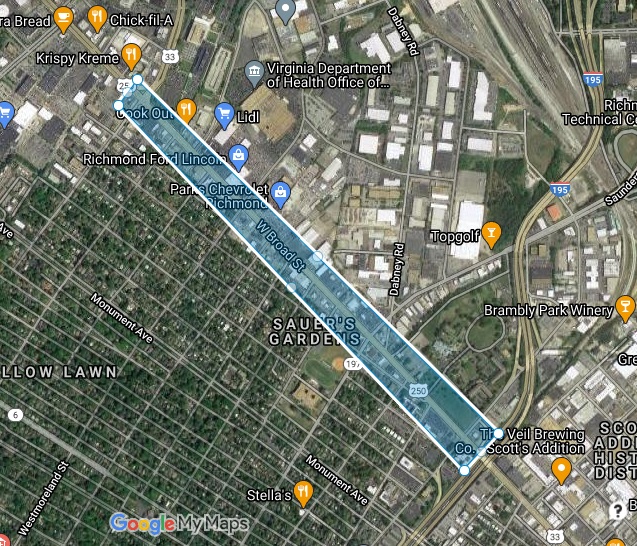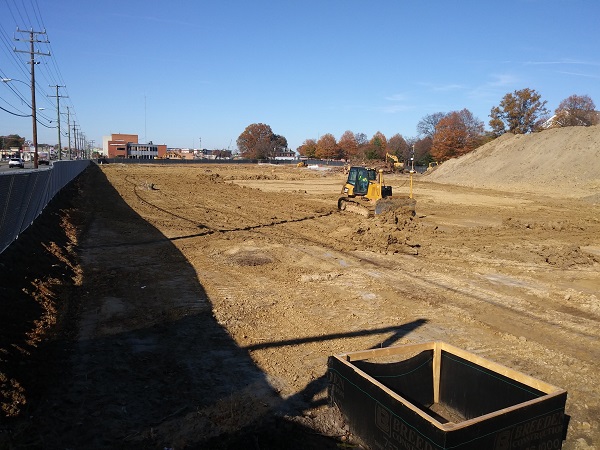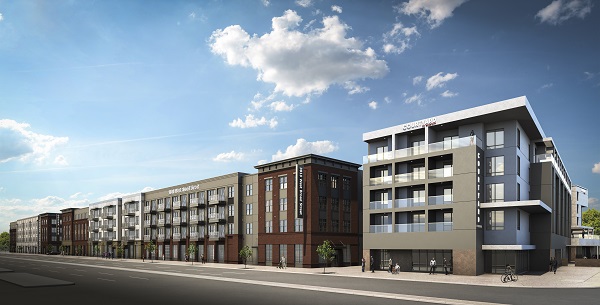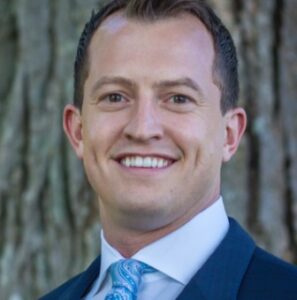
The rezoning would affect properties lining both sides of Broad Street between the expressway and Staples Mill Road. (Courtesy of Google Maps)
While proposed zoning changes along one stretch of Broad Street are getting a second look from city planners, another section of the fast-transitioning corridor is receiving priority from the area’s City Council representative.
First District Councilmember Andreas Addison is pushing an effort to extend the city’s TOD-1 zoning district along Broad, stretching it westward across the Interstate 195 expressway from the Scott’s Addition area to as far as city limits at Staples Mill Road.
The change to TOD-1, or Transit-Oriented Nodal District — a newer zoning designation aimed at encouraging so-called “transit-oriented development” — would essentially follow the vision of the city’s Pulse Corridor Plan, which calls for implementing the zoning essentially along the length of the GRTC Pulse rapid-transit bus line.
But with city planners busy with other zoning change proposals, such as those under review for the so-called “Greater Scott’s Addition” part of town, that vision could be achieved more quickly with Addison’s involvement — or at least that’s his goal.
“I asked where this would fall within a rezoning, and they’re like, ‘We’ve got the Greater Scott’s Addition area, the downtown area — all the other things” that need zoning attention, Addison said. “So I took the initiative of not waiting and, as a city councilperson, requested a rezoning of a part of the city that needs it.”
Noting development occurring on the north side of Broad, where Henrico County borders his West End voter district, Addison added, “Henrico’s going to build a lot of stuff across the street, they’re putting in a new Carvana right near TopGolf, so there’s more things coming. If we don’t match what we can do along this corridor, what’s the point?”
Addison recently introduced a resolution that would declare a public necessity to amend the city’s zoning code to accomplish the rezoning, which would change city properties along both sides of Broad from B-3 General Business District to TOD-1.
While the north side of the street includes Henrico County, street-fronting parcels fall within city limits.
The resolution received support this week from the city’s Land Use, Housing and Transportation Standing Committee, which Addison chairs. It now goes to the City Council, which is set to consider it at its regular meeting Monday.
While the TOD zoning would balance out such development on the south side of Broad — laying the groundwork for generally denser, taller, street-fronting buildings — Addison said the change would also make room for more housing options in his district, a request he heard from constituents during his recent re-election campaign.
“I was asked a lot about affordable housing needed in our community, especially in light of the First District is perhaps one of the most affluent and developed communities in the city. There’s not a lot of places to build stuff.
“I said the Pulse corridor rezoning needs to continue to Staples Mill, because it’s really vacant,” he said. “There’s nothing really much along that corridor. And in all honesty, there’s a lot of good resources there.”

Development activity has picked up along the corridor in recent years, including an infill mixed-use project on the UMFS campus. (BizSense file)
Addison pointed to the UMFS campus, where new infill mixed-use buildings are currently rising, as well as employment centers and grocery stores in the corridor, its proximity to Thomas Jefferson High School and Mary Munford Elementary, and plans for a new Pulse station at Broad and Malvern Avenue.
The corridor’s positioning between Scott’s Addition and Willow Lawn also has drawn interest in adjacent residential neighborhoods, where builders have been fitting in new homes and rehabbing older ones.
The corridor’s proximity to established residential neighborhoods has drawn opposition to other Pulse-driven zoning changes, such as recent proposals for areas across Broad from the Fan District that the city ended up withdrawing late last year.
Addison said he expects his proposal could face similar opposition, but he’s optimistic. In addition to encouraging infrastructure improvements that would enhance the area’s walkability, he said the change would also eliminate the need for case-by-case reviews of development requests that otherwise would require special-use permit approvals.
“Usually rezonings are met with a lot of neighborhood opposition, and I expect some, because there are traffic concerns along Westmoreland Street, especially between Broad and Monument,” Addison said. “I’ve put in a lot of traffic-calming efforts in those areas, and I think people see this as a way of potentially increasing that (traffic).
“But to counter that, I also see the ability of improving the infrastructure — provide more curb-and-gutter sidewalks, traffic calming impacts around this area — because we have to,” he said. “That’s going to be the expectation of what’s built along the Broad Street corridor, where we need to make sure that the neighborhood is walkable, safe, and well-trafficked with managed speeds.”

A rendering of the UMFS development gives an example of the street-fronting buildings that would be encouraged under TOD zoning.
Kevin Vonck, the city’s acting planning director since previous director Mark Olinger’s abrupt departure in January, said he’s supportive of Addison’s approach to the proposal.
“I think it’s something we should definitely investigate and explore. It’s always a little bit tricky when we talk about our border areas with neighboring (localities), but it’s a gateway to the city,” Vonck said. “The timing is good because we’re discussing a number of adjacent large tracts, and it’s important that we look at neighborhoods and broader areas as a whole.”
As for the zoning changes north of the Fan that were put on hold in December, Vonck said the planning department is working on alternative proposals that it plans to present to the Planning Commission and City Council in coming weeks.
He said those proposals could include TOD zoning that he said could serve as a better transition between the commercial and residential areas.
“It’s a tough area because you have one of our more major streets, and then a block away, a well-developed residential area,” he said. “Part of the conversation is how do we get that density and intensity, but in the same way, really respect the historic residential character.”

The rezoning would affect properties lining both sides of Broad Street between the expressway and Staples Mill Road. (Courtesy of Google Maps)
While proposed zoning changes along one stretch of Broad Street are getting a second look from city planners, another section of the fast-transitioning corridor is receiving priority from the area’s City Council representative.
First District Councilmember Andreas Addison is pushing an effort to extend the city’s TOD-1 zoning district along Broad, stretching it westward across the Interstate 195 expressway from the Scott’s Addition area to as far as city limits at Staples Mill Road.
The change to TOD-1, or Transit-Oriented Nodal District — a newer zoning designation aimed at encouraging so-called “transit-oriented development” — would essentially follow the vision of the city’s Pulse Corridor Plan, which calls for implementing the zoning essentially along the length of the GRTC Pulse rapid-transit bus line.
But with city planners busy with other zoning change proposals, such as those under review for the so-called “Greater Scott’s Addition” part of town, that vision could be achieved more quickly with Addison’s involvement — or at least that’s his goal.
“I asked where this would fall within a rezoning, and they’re like, ‘We’ve got the Greater Scott’s Addition area, the downtown area — all the other things” that need zoning attention, Addison said. “So I took the initiative of not waiting and, as a city councilperson, requested a rezoning of a part of the city that needs it.”
Noting development occurring on the north side of Broad, where Henrico County borders his West End voter district, Addison added, “Henrico’s going to build a lot of stuff across the street, they’re putting in a new Carvana right near TopGolf, so there’s more things coming. If we don’t match what we can do along this corridor, what’s the point?”
Addison recently introduced a resolution that would declare a public necessity to amend the city’s zoning code to accomplish the rezoning, which would change city properties along both sides of Broad from B-3 General Business District to TOD-1.
While the north side of the street includes Henrico County, street-fronting parcels fall within city limits.
The resolution received support this week from the city’s Land Use, Housing and Transportation Standing Committee, which Addison chairs. It now goes to the City Council, which is set to consider it at its regular meeting Monday.
While the TOD zoning would balance out such development on the south side of Broad — laying the groundwork for generally denser, taller, street-fronting buildings — Addison said the change would also make room for more housing options in his district, a request he heard from constituents during his recent re-election campaign.
“I was asked a lot about affordable housing needed in our community, especially in light of the First District is perhaps one of the most affluent and developed communities in the city. There’s not a lot of places to build stuff.
“I said the Pulse corridor rezoning needs to continue to Staples Mill, because it’s really vacant,” he said. “There’s nothing really much along that corridor. And in all honesty, there’s a lot of good resources there.”

Development activity has picked up along the corridor in recent years, including an infill mixed-use project on the UMFS campus. (BizSense file)
Addison pointed to the UMFS campus, where new infill mixed-use buildings are currently rising, as well as employment centers and grocery stores in the corridor, its proximity to Thomas Jefferson High School and Mary Munford Elementary, and plans for a new Pulse station at Broad and Malvern Avenue.
The corridor’s positioning between Scott’s Addition and Willow Lawn also has drawn interest in adjacent residential neighborhoods, where builders have been fitting in new homes and rehabbing older ones.
The corridor’s proximity to established residential neighborhoods has drawn opposition to other Pulse-driven zoning changes, such as recent proposals for areas across Broad from the Fan District that the city ended up withdrawing late last year.
Addison said he expects his proposal could face similar opposition, but he’s optimistic. In addition to encouraging infrastructure improvements that would enhance the area’s walkability, he said the change would also eliminate the need for case-by-case reviews of development requests that otherwise would require special-use permit approvals.
“Usually rezonings are met with a lot of neighborhood opposition, and I expect some, because there are traffic concerns along Westmoreland Street, especially between Broad and Monument,” Addison said. “I’ve put in a lot of traffic-calming efforts in those areas, and I think people see this as a way of potentially increasing that (traffic).
“But to counter that, I also see the ability of improving the infrastructure — provide more curb-and-gutter sidewalks, traffic calming impacts around this area — because we have to,” he said. “That’s going to be the expectation of what’s built along the Broad Street corridor, where we need to make sure that the neighborhood is walkable, safe, and well-trafficked with managed speeds.”

A rendering of the UMFS development gives an example of the street-fronting buildings that would be encouraged under TOD zoning.
Kevin Vonck, the city’s acting planning director since previous director Mark Olinger’s abrupt departure in January, said he’s supportive of Addison’s approach to the proposal.
“I think it’s something we should definitely investigate and explore. It’s always a little bit tricky when we talk about our border areas with neighboring (localities), but it’s a gateway to the city,” Vonck said. “The timing is good because we’re discussing a number of adjacent large tracts, and it’s important that we look at neighborhoods and broader areas as a whole.”
As for the zoning changes north of the Fan that were put on hold in December, Vonck said the planning department is working on alternative proposals that it plans to present to the Planning Commission and City Council in coming weeks.
He said those proposals could include TOD zoning that he said could serve as a better transition between the commercial and residential areas.
“It’s a tough area because you have one of our more major streets, and then a block away, a well-developed residential area,” he said. “Part of the conversation is how do we get that density and intensity, but in the same way, really respect the historic residential character.”




Maybe underground parking is a solution?
Who honestly cares about parking? Try being a city. Parking is something that can be complained about with any development.
Wow, ten upvotes on this comment — and it’s the most detached from reality. Plenty of people care about parking.
Clearly they don’t – it’s just you – your reality isn’t the reality for everyone
It’s NOT just me. In fact, I have often been one of those people that wondered “why do people not come downtown because they will have to walk a bit? If they go to a mall, they still have to walk from where they parked to the door, and then walk inside the mall. No, it is people like you who deny the existence of realities that you don’t like —- I have taken the time to outlay my thoughts — I have often thought I could be VERY happy living in a studio apt IF it was on a… Read more »
Yeah but normal cities have parking garages
Guess Addison does not realize Carvana is actually in the City.
It’s not West Mooreland Street, but Westmoreland Street. There’s a North and South Mooreland Road in Henrico.
I think this is smart. I would welcome some density along Broad heading to Willow Lawn. The current land use is fairly ugly and wasteful, and if it’s not updated now, we might end up with another 50 years of squandered opportunity. Smart developers will figure out how to add parking too because the marketplace will demand it. But when it comes to affordable housing, the connection to public transportation is essential.
I certainly agree with this. Perhaps this is the stealth reason for the BRT?? To be able to increase height and density in a city that historically would rather miss opportunities than change a bit? A city has to grow when the conditions are ripe. You don’t try to shape iron when it is cold, if you are able to learn not to.
I live in Mavern Gardens and would ride the Pulse frequently if they added a stop at Broad/Malvern. As it is, I have to walk 15-20 minutes to Scott’s addition stop so have only used it a couple of times. I love cheap public transportation options for going to the National or any venue or restaurant downtown and in between. I live in a city because I don’t want to be car-centric.
Second this. The Malvern stop will be greatly appreciated. That gap bothered me from the beginning.
This is very good idea. West Broad out to Willow Lawn and further is a viable corridor for urbanization. Wealthier neighborhoods in the West End need to do their part in creating more housing, not just lower income areas which are often up-zoned. This will improve the surrounding residential neighborhoods by providing more amenities within walking distance.
The Pulse has exceeded my, and probably everyone’s, expectations. But due to it’s overall geography Richmond is a car town and needs parking spaces for both residents and visitors. One can see the pros & cons now with their own eyes. Downtown has a good deal of available on-street and garage parking because office buildings are still largely empty as employees are working from home. But finding parking anywhere is Shockoe Bottom, day or night, is extremely difficult because apartment developers weren’t required to build adequate parking for residents. Hence they park on the street, which discourages visitors and local… Read more »
Overreaction to parking. Every project has complainers complaining about parking from the Diamond to downtown.
Every project certainly DOES have complainers of one kind or another — are you trying to say that the parking one is the most invalid complaint? From my point of view, for the people who actually live, work and do business in such areas — it is perhaps the ONE thing that unites all political viewpoints. I would LOVE it if Richmond and Petersburg’s leaders would do something that would benefit EVERYONE — build a nice big parking garage that a core area could grow into. Heck, even tiny Harrisonburg, VA has a big oversized parking garage. Perhaps because the… Read more »
Bad idea boomer
I will be the first to say that I am ignorant of how well Pulse has done — has it done well? Where can I see evidence of this.
Yes, in the town I grew up near, not only did businesses complain there was not enough parking (I am thinking about the 1990s) but I had a friend that lived in a beautiful old multistory apt building, but it was CRAZY how he had to worry about parking and MOVE HIS CAR uselessly from one spot to another when he wasn’t at work.
The Pulse has outperformed in ridership estimates but underperformed in revenue. Believe it or not you don’t have to prove you paid a fare to get on, it’s more or less the “honor system”. I believe it was determined that validating everyone had paid when take too long and therefore undermine the idea of the Pulse being quick. They have spot fare checks but assume they might not even be doing them anymore due to Covid. I think all of GRTC went fare free during Covid to avoid human contact. You would think ridership would be at all time highs… Read more »
It is currently fare-free but non-essential travel is discouraged. As a regular user I have avoided it for this reason (also less places to travel as you stated). I know they are discussing trying to make it fare-free going forward and I would be curious the difference in cost without the need to maintain a fare system and associated security. I have been seeing reports that the Pulse is still surpassing expectations even without ridership being at its pre-pandemic high.
Well that is interesting information. I am glad ridership is doing well but do not like the free-rider thing. In Berlin, while I was there, there was an honor system, but, like most socialized countries, there needed to be a lot of HONOR in the populace to make the socialism work — you bought one ride, day/month pass etc… no one checked you and if you wanted to take just one ride, it was not likely you would get caught. It was what I called “The Reverse Lottery” — every once in a while, your subway would reach a station… Read more »
The biggest issue with that stretch of Broad Street is all the insane motorcycle/moped speeders who come out during night (esp. I think either Wed or Thurs) and make a ridiculous amount of noise and area really dangerous drivers. Is there some sort of anti-crazy moped riders zoning we could apply to the area?
A bigger issue, especially in the AM, is how all of the left turns make the left hand lanes useless. Between that and the many busses in the morning it’s quite a slog at times. I’m all for mass transit and I just want the left hand lane issue resolved.
Great idea. That stretch of Broad is currently awful, and could be much better.
They should extend the pulse lanes to willow lawn
It is truly astounding to see how many readers here simply do not understand the grave need for parking in the City. The fact that we built the Pulse Line without a single commuter parking lot defies all rational and logical sense, as well as prudent planning. I suppose if one isn’t personally affected by the lack of parking, and only seeing the financial benefit, they can denounce the pleas for parking to be addrrssed. They should be listening to those who live and frequent these “corridors” as parking could, and should, be an easy solution – however one must… Read more »
I agree that they should have done a better job with adding parking at key stops, such as the Science Museum as it is a gateway location via Boulevard. Willow Lawn has ample parking and Rocketts has quite a bit but agreements could have been made for more clear commuter parking. The amount of street parking actually lost was not terribly much and I have personally found parking easier in the Arts District since the Pulse operations began. Still, for future planning, and since street parking is increasingly becoming metered anyway, it would be great if the city would work… Read more »
Yes, Ashley, I am seeing this too. As someone with zero skin in the game other than an interest and desire to see “Richmond work” and be a more vibrant, prosperous city, I worry about all the ideologouges and puritans who counter practical arguments with “That all works well in fact, but does it in THEORY???” I may be wrong, but I remember the wonderful downtown where I grew up having a great deal of trouble competing with the suburbs and malls — the downtown had a lot worse problems than parking, but as far as character, it was unmatched… Read more »
As someone from the “suburbs” who has visited downtown a bunch a many restaurants in Scotts Addition I can tell you parking is a big issue if you are not ultra familiar with the area. If you “know” the area you usually know where you can find close spots, if you don’t you can spend much time circling the blocks trying to find a valid spot. Heck there have been many times where I am not sure I am even interpreting the street signage correctly when it comes to when on street parking is appropriate on weekends and after hours.… Read more »
Perhaps there’s a better solution than building copious amounts of parking. Over the years, visiting friends in New York/New Jersey, it’s been fascinating to watch the deployment of parking apps and technology – mostly systems that locate and reserve garage spaces and allow for cost comparison. Obviously, Richmond doesn’t quite need that level of tech, but perhaps technology could be deployed to make it easier for folks who don’t park in the city every day to figure out the ropes? I could see an app that gave precise, visual, block by block information about parking rules and restrictions being useful,… Read more »
This is not New York or DC or Baltimore all of which have parking garages
Okay, this all “makes sense” in all of it’s internal logic, and I get it — I happen to LOVE cities that you can just drop in carless and get everywhere with public transit and your feet, and I understand how it helps everyone when the working poor can easily get about with rapid transit without a car — I have been in both situations, and when my car wasn’t working, taking a slow bus with lots of stops and criss-crossy routes really was a drag. Still, what is the reality of what is going on? I am not around… Read more »
Spend less time writing novels on the comment section of bizsnese
Spend less time writing dumb comments that add nothing.
I like this in that their are no trees or green space to cut down in this location. I also notice that the new devopements replacing this mess of car dealerships and parking lots seems to be far better looking and landscaped.